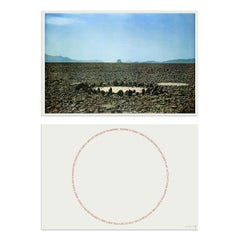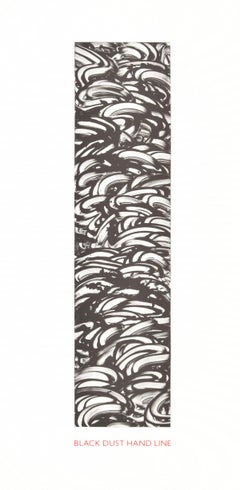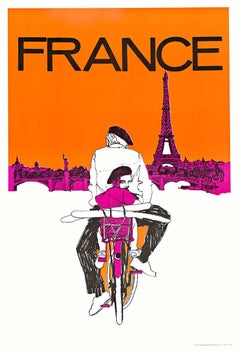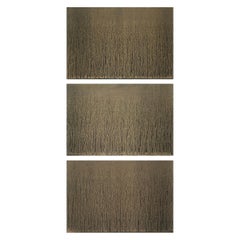Richard Long Prints and Multiples
to
1
1
Overall Width
to
Overall Height
to
3
1,183
937
886
817
2
1
1
2
2
1
1
Artist: Richard Long
Richard Long, Two Sahara Works - Set of 1 Grano Lithograph and 1 Silkscreen
By Richard Long
Located in Hamburg, DE
Richard Long (British, b. 1945)
Two Sahara Works, 1988
Medium: Set of 1 grano lithograph and 1 silkscreen, on rag paper
Dimensions: each 63 x 93 cm (24¾ x 36½ in)
Edition of 75: each...
Category
20th Century Land Richard Long Prints and Multiples
Materials
Lithograph, Screen
Richard Long Lithograph / Screenprint, 62.5"H
By Richard Long
Located in Lake Worth Beach, FL
Artist/Designer; Manufacturer: Richard Long (b. 1945)
Marking(s); notes: signed; ed. 23/60; 1990
Country of origin; materials: <...
Marking(s); notes: signed; ed. 23/60; 1990
Country of origin; materials: <...
Category
Late 20th Century Richard Long Prints and Multiples
Materials
Lithograph, Screen
Related Items
Original Op Art Abstract Color Screenprint "Planetary Folklore" Signed #2/250
By Victor Vasarely
Located in Portland, OR
A Op Art abstract color screenprint, "Planetary Folklore" 1968, by Victor Vasarely (1906-1997).
This very striking work by Vasarely is comprised of various colorful geometric shapes, the work is signed lower right "Vasarely" and numbered lower left "2/250. This is an early and crisp impression in excellent condition and housed under glass in a gilt & silvered hardwood frame.
This very eye-catching work by one of the 20th century's leading Op artists is ready to hang on your wall.
14" x 14.50" at sight without frame
Numered 2/250
A Franco-Hungarian painter, Victor Vasarely (1906-1997) first studied medicine before turning to art. In Budapest, he frequented artists from the Hungarian Bauhaus...
Category
1960s Op Art Richard Long Prints and Multiples
Materials
Lithograph, Handmade Paper, Color, Screen
$1,895
H 25.5 in W 26 in D 2 in
France via Bicycle and French Bread serigraph
Located in Spokane, WA
Original France travel by bicycle (and French bread) vintage serigraph poster, excellent condition, ready to frame. These images are of the exact rare poster you will receive. Ar...
Category
1970s Post-Modern Richard Long Prints and Multiples
Materials
Screen
$398 Sale Price
20% Off
H 24.5 in W 23 in D 0.05 in
Düsseldorf (German Cities) by Dieter Roth monuments vintage postcard light blue
By Dieter Roth
Located in New York, NY
Düsseldorf (German Cities), 1970
24 x 33.8 in. / 61 x 86 cm
Screen print in one color on offset lithograph, black on white card. “for Paul” written in pencil lower middle. Signed and...
Category
1960s Abstract Richard Long Prints and Multiples
Materials
Lithograph, Screen
Téléphone-homard cybernétique (Michler/Löpsinger 822-831; Field 75-13)
By Salvador Dalí
Located in Fairfield, CT
Artist: Salvador Dali (1904-1989)
Title: Téléphone-homard cybernétique (Michler/Löpsinger 822-831; Field 75-13), Imaginations et Objets du Futur (Cybernetic lobster phone, Imaginatio...
Category
1970s Surrealist Richard Long Prints and Multiples
Materials
Mixed Media, Drypoint, Lithograph, Screen
$22,800 Sale Price
20% Off
H 28.5 in W 21 in
Peace Through Chemistry I, 1970, C.97
By Roy Lichtenstein
Located in Palo Alto, CA
Roy Lichtenstein, Peace Through Chemistry I (1970), masterfully fuses the aesthetic of commercial illustration with a biting commentary on industrial modernity, science, and human a...
Category
1970s Richard Long Prints and Multiples
Materials
Lithograph, Screen
Original Continental Airlines limited edition Serigraph vintage travel poster
Located in Spokane, WA
Original Continental Airlines travel poster. Linen backed in fine condition. Signed and numbered 35/50.
This original Continental Airlines poster is an artistic representation of regional destinations prominently served by Continental Airlines in the past. The design is modern and bold, showcasing a unique black-and-white theme with strong, futuristic typography and graphical illustrations. Each city is creatively depicted using stylized imagery that resonates with its character—Oklahoma City features a cowboy motif, New Orleans embraces a jazzy, cultural essence, Dallas reflects the energy of movement, and Midland/Odessa highlights industrial and oil-centric themes.
This limited-edition poster is printed in black and white. It features the destinations of Hawaii, San Francisco, Albuquerque and Portland Above each name is a design that represents each destination city.
Hawaii has rows of palm trees and hula dancers. San Francisco has rolling hills and cable cars. Albuquerque has tribal Indians dancing. Portland has the cruise shipping. This image features the Saul Bass l967 Continental logo in the design.
Continental Airlines was a major United States airline founded in 1934 and eventually headquartered in Houston, Texas.
The airline was acquired by UAL Corporation, the parent company of United Airlines, on October 1, 2010.
This is an original vintage Continental Airlines poster...
Category
Late 20th Century American Modern Richard Long Prints and Multiples
Materials
Screen
$675
H 40 in W 26.5 in D 0.3 in
Antiombrelle à atomiseurs de liquides (Michler/Löpsinger 822-831; Field 75-13)
By Salvador Dalí
Located in Fairfield, CT
Artist: Salvador Dali (1904-1989)
Title: Antiombrelle à atomiseurs de liquides (Michler/Löpsinger 822-831; Field 75-13), Imaginations et Objets du Futur (Liquid atomizer anti-shade, ...
Category
1970s Surrealist Richard Long Prints and Multiples
Materials
Mixed Media, Drypoint, Lithograph, Screen
$8,400 Sale Price
20% Off
H 28.5 in W 21 in
Human Rights 1981, Robert Rauschenberg
By Robert Rauschenberg
Located in Fairfield, CT
Artist: Robert Rauschenberg (1925-2008)
Title: Human Rights 1981
Year: 1981
Medium: Silkscreen and lithograph on wove paper
Edition: 41/100, plus proofs
Size: 31 x 23 inches
Conditio...
Category
1980s Pop Art Richard Long Prints and Multiples
Materials
Lithograph, Screen
$5,200 Sale Price
20% Off
H 31 in W 23 in
Modern Print /// Roy Lichtenstein Pop Art Abstract Geometric MoMA Gemini G.E.L.
By Roy Lichtenstein
Located in Saint Augustine, FL
Artist: Roy Lichtenstein (American, 1923-1997)
Title: "Modern Print"
*Numbered, signed, and dated by Lichtenstein in pencil lower right
Year: 1971
Medium: Original Lithograph and Scr...
Category
1970s Pop Art Richard Long Prints and Multiples
Materials
Lithograph, Screen
City, Bicentennial Pop Art Lithograph and Screenprint by Constantino Nivola
By Costantino Nivola
Located in Long Island City, NY
A busy illustration of a city street, likely in New York. The base of the image is done entirely in black line work and shouts of primary color are randomly dashed across various fig...
Category
1970s Pop Art Richard Long Prints and Multiples
Materials
Lithograph, Screen
Baignoire à tornade liquide (Michler/Löpsinger 822-831; Field 75-13)
By Salvador Dalí
Located in Fairfield, CT
Artist: Salvador Dali (1904-1989)
Title: Baignoire à tornade liquide (Michler/Löpsinger 822-831; Field 75-13), Imaginations et Objets du Futur (Liquid tornado bathtub, Imaginations a...
Category
1970s Surrealist Richard Long Prints and Multiples
Materials
Mixed Media, Lithograph, Drypoint, Screen
$6,000 Sale Price
20% Off
H 28.5 in W 21 in
Basket Series, Dale Chihuly
By Dale Chihuly
Located in Fairfield, CT
Artist: Dale Chihuly (1941)
Title: Basket Series
Year: 2013
Medium: Intaglio and acrylic on Waterford paper
Edition: 143/160
Size: 37 x 25 inches
Inscription: Signed and numbered by ...
Category
2010s Abstract Richard Long Prints and Multiples
Materials
Acrylic, Intaglio, Lithograph, Screen
Previously Available Items
Richard Long, River Avon Mud Drawings (1989) - Signed Prints, British Artist
By Richard Long
Located in Hamburg, DE
Richard Long (British, b. 1945)
River Avon Mud Drawings, 1989
Medium: Set of 3 granolithographs and 1 silkscreen (title page)
Dimensions: each 65 x 96 cm (25½ x 37½ in)
Edition of 60...
Category
20th Century Abstract Richard Long Prints and Multiples
Materials
Lithograph, Screen
Richard Long, Two Sahara Works - Set of 1 Grano Lithograph and 1 Silkscreen
By Richard Long
Located in Hamburg, DE
Richard Long (British, b. 1945)
Two Sahara Works, 1988
Medium: Set of 1 grano lithograph and 1 silkscreen, on rag paper
Dimensions: each 63 x 93 cm (24¾ x 36½ in)
Edition of 75: each...
Category
20th Century Land Richard Long Prints and Multiples
Materials
Lithograph, Screen
Richard Long prints and multiples for sale on 1stDibs.
Find a wide variety of authentic Richard Long prints and multiples available for sale on 1stDibs. You can also browse by medium to find art by Richard Long in lithograph and more. Much of the original work by this artist or collective was created during the 21st century and contemporary and is mostly associated with the contemporary style. Not every interior allows for large Richard Long prints and multiples, so small editions measuring 22 inches across are available. Customers who are interested in this artist might also find the work of Harland Miller, Antony Gormley, and Katie Edwards. Richard Long prints and multiples prices can differ depending upon medium, time period and other attributes. On 1stDibs, the price for these items starts at $3,979 and tops out at $3,979, while the average work can sell for $3,979.





